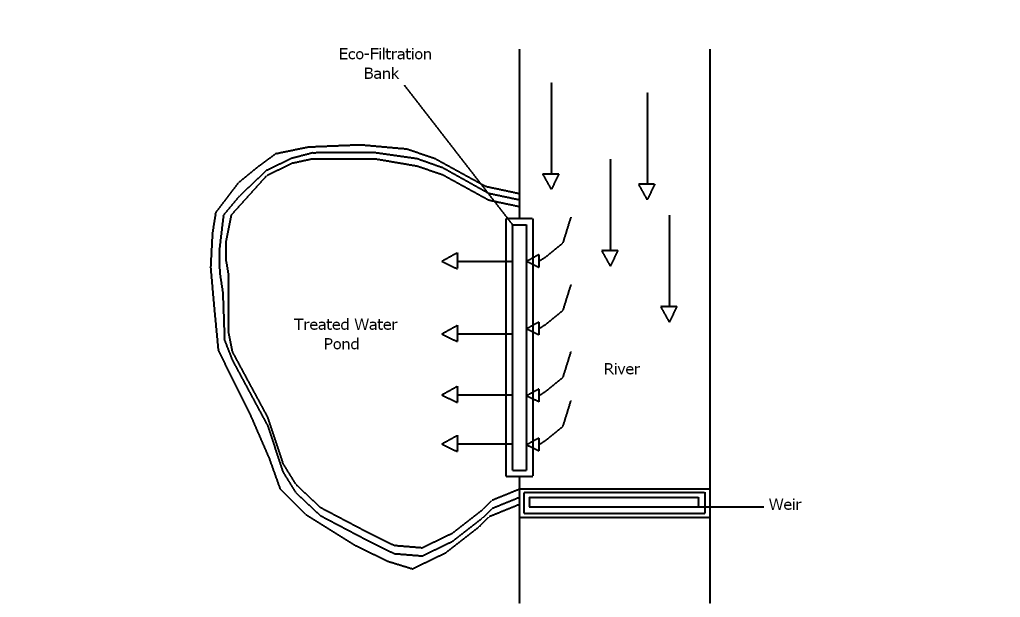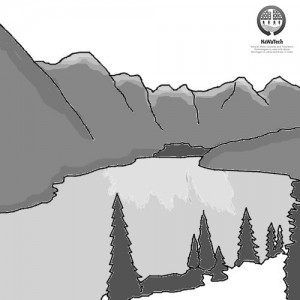Executive Summary
Eco-filtration Bank (EFB) is a variant of Green Bridge Technology – in-stream horizontal eco-filtration process. Contaminated water in the small stream or tributary is filtered through an enclosure in the bank of the stream made up of locally available stones and sand for protection of biofilms, which degrade pollutants. They are absorbed in the micro-ecosystem. Thus the desired quantity of water in the stream can be purified for desired application.
| The contents of this factsheet are results of the Indo-European Project NaWaTech- “Natural Water Systems and Treatment Technologies to cope with Water Shortages in Urbanised Areas in India”, co-financed by the EC and the DST – India. |
Design and Construction Principles

Eco-Filtration Bank
Contaminated water in the stream is diverted by constructing a porous weir of desired height to ensure the designed flow enters into the EFB. The screen box (coarse and fine) should be installed upstream of the EFB to trap the non-biodegradables from the water. The size, shape and porosity will be dependent on the concentration of non-biodegradable, inert floating materials. In the weir created small impounding, some natural flocculation and settling takes place which helps in removal of pollutants. EFB acts as an ecological filtration involving adsorption, absorption and biodegradation of pollutants taking place in the biofilms developed on the filtration media of locally available stones and gravels. This process can be accelerated by adding specialised bacterial cultures. Treated water is collected in the adjacent pond lined with stones. Water retention due to weir is about 11 minutes. Filtration is instantaneous; time required is not more than 1 minute. Treated water pond has retention time of 24 hours. Filtration area of EFB is 0.14 m2/PE (1 PE = 135 L/d) suitable for dense areas also. EFB is constructed using locally available stones, gravels and coarse sand with some specially enriched natural non-pathogenic microbes. The Screen-box can be made of mild steel coated with anti-corrosive paints. Weir is made of rubbles and stones. EFB improves the dissolved oxygen concentration and facilitates the ecological elimination of pathogens in the range of 90 - 99%. Reduction in BOD is expected to be in the range of 50 – 70%.
Operation and Maintenance
EFB is a zero electricity technique and does not require any chemical inputs for the removal of contaminants. It is based on the ecological principles of self-purification of running water bodies. It needs routine removal of non-biodegradable materials from the screen box. These materials shall be transported to common solid waste processing site. Settled solids from the impounded area before weir shall be removed once in six months. These solids being bio-stabilised can be effectively used as organic manure for the gardens. The treated water pump shall be operated every day for watering of the community gardens and green belts in the vicinity. Routine operations are very simple and can be managed by the local community.
Cost Considerations
Estimated construction cost of the EFB are inclusive of screen box, weir, EFB unit, treated water pond and simple barbed wire fencing with labour, supervision, and plantation per PE is about 30% that of conventional or advanced treatment units. Electro-mechanical costs involving the pump and treated water distribution pipeline are hardly 20% of conventional treatment system. Therefore, the project costs are the sum total of costs for construction and mechanical labour with additional costs of landscaping and beautification of the treatment area converting it into a river-side landscape. Being demonstrative project, community expects external financing support. Operational costs (including costs for screen cleaning, biosolids removal and pumping) are 5% that of conventional systems.
Experiences in Europe and other Cities of the World
Eco-Filtration Bank is a combination of chemical and ecological principles of bank filtration and green bridge – horizontal eco-filtration. There is no example of eco-filtration bank in Europe since it is a recent innovation in India. First of its kind was developed for a farmer to use water for irrigation from the ecological restoration project on Ahar river in Udaipur, Rajasthan state. An Eco-filtration bank is designed to purify the polluted water flowing through the stream by passing through the porous green banks by facilitating combined action of green vegetation and microorganisms. This process may produce potable water directly, or may act as a simple pre-treatment for further purification. There are three filtration mechanisms involved, namely, physical filtration (straining through interstitial spaces of alluvial soil/sand), biological filtration (soil microorganisms remove dissolved or suspended organic material and chemical constituents), and ion exchange (aquifer soils react with soluble chemicals in the water). An Eco-filtration Bank has a designated efficiency to remove suspended solids, COD, BOD and faecal coliforms because of aerobic processes. Reduction in micro-pollutants, removal of the pathogen and suspended solids are also noted in European riverbank filtration systems (DE VET et al. 2009; SCHMIDT et al. 2003).
Experiences in India
Ecotechnology for water purification is fundamentally the discipline of sustainable water resources management, which promises the restoration and preservation of ecological health of the water body for human use through the integration of engineering and ecological principles. It operates within the borders of a ecosystem. Therefore, it has got non-conventional design considerations, parameters and scale ups. These considerations are dependent on the self-designing and controlling abilities of ecosystems. When changes occur in the river and lake systems due to external inputs, nutrient discharges, releases of pollutants are reorganised and balanced. This is the scientific basis of the green bridge (horizontal eco-filtration) technique, which can be harnessed for the eco-filtration bank method of purification to facilitate the treatment of desired quantity of stream or lake water.
Farmers are using the eco-filtration bank system along the Ahar River Udaipur India. It was polluted untill December 2009 due to city drains and industrial discharges about 150 MLD (KODARKAR & JOSHI n.y.). The river lost its ecological health, biodiversity and usefulness for routine human activities in the urban and rural areas downstream of Udaipur to organic and toxic pollutants. But the quality of water changed due to the ecological restoration design having an in-situ green bridge system and eco-filtration banks. Farmers are now getting enough clean water for the cultivation of vegetables.
Buddha NEER project is a federal government initiative involving the Ministry of Environment and Forests, Central Government, National River Conservation Directorate (NRCD), Central Pollution Control Board (CPCB), Punjab Government, Punjab Pollution Control Board (PPCB) and Ludhiana Municipal Corporation (LMC) to restore the ecological health ofa highly polluted stream of dry weather flow of 600 MLD to make the water available for agriculture. In-stream green bridges with eco-filtration banks are being developed to reduce the pollution and toxicity levels of Buddha stream water.
The major challenges in treating the running water bodies in India are ingress of liquid waste discharges and disposal of solid wastes. All the initial field scale applications were supported by local communities and funded by industrial organisations as corporate social responsibility. Out of them, 50% systems are still running successfully. There is a need for sustainable, uninterrupted financing for their long-term operations. The Government of India has come forward with a technology assessment programme for the adaptation of such technologies. So there are hopes that in the future, the treatment systems will be run efficiently with sustainable funding.
The eco-filtration bank system is found to be suitable for integration with green belts or city garden plans or any other treatment systems because –
- No requirement of extra space. So, space footprint as compared to conventional
systems is negligible.
- Zero electricity ecological correction system as there is no requirement of pumping or machinery to introduce oxygen for aerobic degradation or there is no sludge handling.
- Capital expenditure and operational costs are considerably less as compared to conventional engineered treatment systems.
- Ecological treatment systems are easily adaptable in cultural fabric of Indian urban and rural set ups as the local resident communities owned the systems by participating in the installation of the systems and routine operations and monitoring of improvements in water body.
| The research leading to these results has received funding from the European Union Seventh Framework Programme ([FP7/2007-2013]) under Grant Agreement N° [308336] and the Department of Science and Technology of the Government of India DS.O DST/IMRCD/NaWaTech/ 2012/(G). |
Water Quality and Treatment of Riverbank Filtrate
This paper discusses the origin and fate of macro pollutants in river bank filtrate, based on extensive full-scale measurements in well fields and treatment systems of the Drinking Water Company Oasen in the Netherlands.
DE VET, W.W.J.M. ; VAN GENUCHTEN, C.C.A. ; VAN LOOSDRECHT, M.C.M. ; VAN DIJK, J.C. (2009): Water Quality and Treatment of Riverbank Filtrate. In: Drinking Water Engineering and Science Discussions: Volume 2 , 127-159. URL [Accessed: 15.04.2013]ILBM Impact Story - Ecological Restoration of Highly Polluted Stretch of Ahar River, Udaipur and Ecological Improvement of Udaisagar Lake, Rajasthan, India
Ecological restoration of Ahar River in Udaipur and the subsequent improvement of Udaisagar Lake have together become a landmark in the application of ILBM principles to successfully convert an aerobically dead river into a living lotic system. This was initiated in the ILBM meeting organized in August 2009 and then within 63 days the ecotechnological Green Bridge system was developed after getting four of the pillars – policy, institutions, finance and public participation to support knowledge and technology pillars to revitalize a terminal lake – Udaisagar Lake by treating the wastewaters flowing through the Ahar River.
KODARKAR, M. JOSHI, S. (n.y): ILBM Impact Story - Ecological Restoration of Highly Polluted Stretch of Ahar River, Udaipur and Ecological Improvement of Udaisagar Lake, Rajasthan, India. URL [Accessed: 19.03.2015]Compendium of Natural Water Systems and Treatment Technologies to cope with Water Shortages in Urbanised Areas in India
The Compendium of NaWaTech Technologies presents appropriate water and wastewater technologies that could enable the sustainable water management in Indian cities. It is intended as a reference for water professionals in charge of planning, designing and implementing sustainable water systems in the Indian urban scenario, based on a decentralised approach.
BARRETO DILLON, L. ; DOYLE, L. ; LANGERGRABER, G. ; SATISH, S. ; POPHALI, G. (2013): Compendium of Natural Water Systems and Treatment Technologies to cope with Water Shortages in Urbanised Areas in India. Berlin: EPUBLI GMBH URL [Accessed: 11.12.2015]http://www.nawatech.net/
This is the official webpage of the NaWaTech Collaborative Project, containing all key information related to the different case studies, activities and results of the project.



